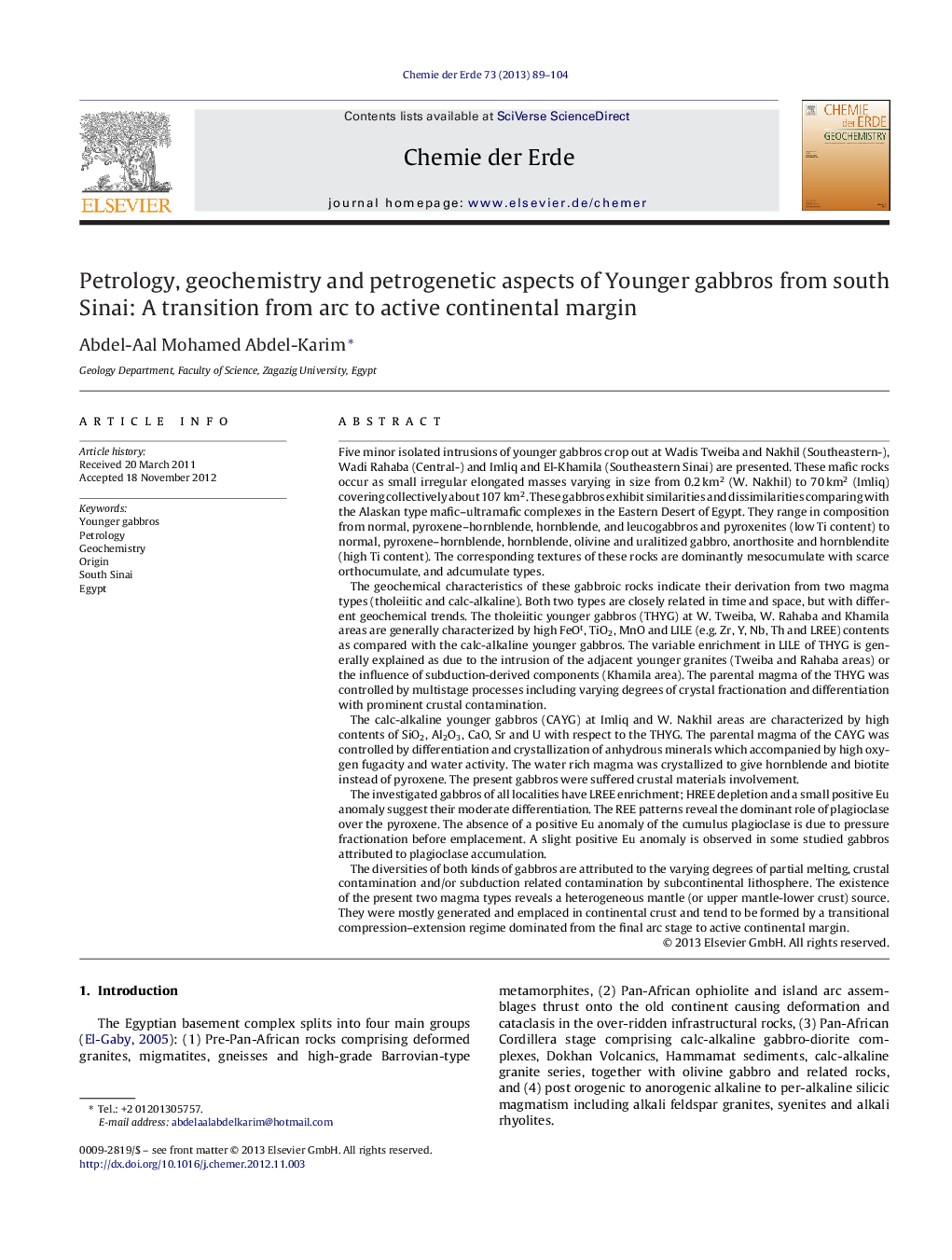| کد مقاله | کد نشریه | سال انتشار | مقاله انگلیسی | نسخه تمام متن |
|---|---|---|---|---|
| 4406827 | 1307322 | 2013 | 16 صفحه PDF | دانلود رایگان |

Five minor isolated intrusions of younger gabbros crop out at Wadis Tweiba and Nakhil (Southeastern-), Wadi Rahaba (Central-) and Imliq and El-Khamila (Southeastern Sinai) are presented. These mafic rocks occur as small irregular elongated masses varying in size from 0.2 km2 (W. Nakhil) to 70 km2 (Imliq) covering collectively about 107 km2. These gabbros exhibit similarities and dissimilarities comparing with the Alaskan type mafic–ultramafic complexes in the Eastern Desert of Egypt. They range in composition from normal, pyroxene–hornblende, hornblende, and leucogabbros and pyroxenites (low Ti content) to normal, pyroxene–hornblende, hornblende, olivine and uralitized gabbro, anorthosite and hornblendite (high Ti content). The corresponding textures of these rocks are dominantly mesocumulate with scarce orthocumulate, and adcumulate types.The geochemical characteristics of these gabbroic rocks indicate their derivation from two magma types (tholeiitic and calc-alkaline). Both two types are closely related in time and space, but with different geochemical trends. The tholeiitic younger gabbros (THYG) at W. Tweiba, W. Rahaba and Khamila areas are generally characterized by high FeOt, TiO2, MnO and LILE (e.g. Zr, Y, Nb, Th and LREE) contents as compared with the calc-alkaline younger gabbros. The variable enrichment in LILE of THYG is generally explained as due to the intrusion of the adjacent younger granites (Tweiba and Rahaba areas) or the influence of subduction-derived components (Khamila area). The parental magma of the THYG was controlled by multistage processes including varying degrees of crystal fractionation and differentiation with prominent crustal contamination.The calc-alkaline younger gabbros (CAYG) at Imliq and W. Nakhil areas are characterized by high contents of SiO2, Al2O3, CaO, Sr and U with respect to the THYG. The parental magma of the CAYG was controlled by differentiation and crystallization of anhydrous minerals which accompanied by high oxygen fugacity and water activity. The water rich magma was crystallized to give hornblende and biotite instead of pyroxene. The present gabbros were suffered crustal materials involvement.The investigated gabbros of all localities have LREE enrichment; HREE depletion and a small positive Eu anomaly suggest their moderate differentiation. The REE patterns reveal the dominant role of plagioclase over the pyroxene. The absence of a positive Eu anomaly of the cumulus plagioclase is due to pressure fractionation before emplacement. A slight positive Eu anomaly is observed in some studied gabbros attributed to plagioclase accumulation.The diversities of both kinds of gabbros are attributed to the varying degrees of partial melting, crustal contamination and/or subduction related contamination by subcontinental lithosphere. The existence of the present two magma types reveals a heterogeneous mantle (or upper mantle-lower crust) source. They were mostly generated and emplaced in continental crust and tend to be formed by a transitional compression–extension regime dominated from the final arc stage to active continental margin.
Journal: Chemie der Erde - Geochemistry - Volume 73, Issue 1, March 2013, Pages 89–104